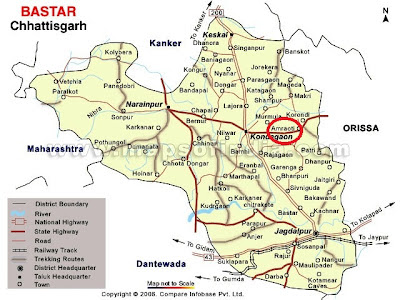Amravati Shiv temple
(A blog by Jitendra Nakka)
(A blog by Jitendra Nakka)
Introduction
Sometimes some areas get hided, sometime some regions get abandoned, sometime some places get lost…..if you have an interest, a zeal to discover, to search , to find something new…..hold on !!!…there are a lot of uncertainties, a lot of secrets, a lot of mysteries hidden in the laps of a place called BASTAR. Bastar is not just a place, not just a district, not just a division, in fact it’s a saga of great past of royal dynasties, prosper art and culture and a series of developed civilization.
Have you ever heard of a temple which is a combination of half made of bricks and half carved on rocks? Mmmm……the answer may be either “yes” or “no”. Well, if the answer may be “yes” also, the no. of such creations might be countable in fingers all over in India. One such divine destination is the Amravati Shiv Temple.
Where and how to reach?
Amravati is a small village situated 20kms away on the east of District Headquarter Kondagaon. Kondagaon is nearly 75 kms to the North of Divisional Headquarter Jagdalpur. As for Lodging and Boarding, the perfect destination is Jagdalpur, where there are numerous hotels provide all comforts and ease with some exciting packages for the tourism of the surrounding areas of Bastar (Division). From Raipur, Kondagaon is nearly 225 kms away in NH-30(earlier called as NH-43).
Courtsey: www.mapsofindia.com
Archeological and Religious Importance:
It is interesting to know, that Bastar was the land of some great dynasties who contributed a lot to its art and culture. Either may be Nal Dynasty, or may be Gang Dynasty, may be Chhindak Nagwanshis, or may be Kaktiya Dynasty……each dynasty adored some areas of Bastar and developed them in the best way they can. Among them, one of the earliest dynasties found in Bastar Division was Nal Dynasty (04th – 07th Century A.D.), which adored the surrounding areas of Kondagaon upto the mid-way of Narayanpur and led the foundation of great temple series of Vishnu, Gobarhin and Banjarin.
This temple of Amravati is an abode of Lord Shiva which is represented by centrally placed very ancient Shiv-ling along with great ancient monuments of Lord Vishnu, Uma-Maheshwar, e.t.c. In the areas of Garh-dhanora, there are some ancient idols found which seems to be of the age of Nal Dynasty having the same resemblance as that of the idols found here in Amravati temple (“according to my perception”). This temple is of much importance as this area receives high attention of the local and surrounding area people. On the occasion of Shiv-ratri, one has to face a huge rush of worshippers, followers and devotee peoples in order to once have a view of Lord Shiva (shiv-ling).
There is need of much research work to be done on the area of Kondagaon, as the area suffers lack of enough historical data to bring out a clear picture. Currently, it’s not a protected monument and still strives for the attention from Archeological Survey of India.
Art and Sculpture:
The temple shows a unique combination of two style of temple formation together to form a single temple. From the front side, we can observe the temple part formed by bricks (might have been built later than the rocky part). In the back side, we can observe a beautiful but nearly devastated temple part formed out of large pieces of rocks which, as told by the fellow villagers, has been used as roof which stands out by the help of small rock pillars. The rocky roof, is in oval shape, and as told by the fellow villagers, is meant as the form of natural shiv-ling formed there by the grace of Lord Shiva himself.
Picture showing rocky part of temple bulging out over the later built brick temple part
Picture showing the back view of the temple showing the rocky temple part
In the temple we can observe many idols which resembles with the style of sculpture and way of formation we have seen in the areas of Garh-dhanora where a lot of archeological monuments had been found by Archeological Survey of India, indicating the age of the Garh-dhanora monuments to of the age of 4th – 7th Century A.D. But as this temple has still not received the attention of Archeological Survey of India, the assumption of exact age of this temple and the actual creator(dynasty) of this temple is very “uncertain”.
Inside temple, we can observe a long idol of Lord Vishnu which has a unique style of art where a cloth starts from one wrist , then goes to thighs and ends back to wrist of another hand (seems like similar to the idols of Lord Vishnu, one can observe in Garh-dhanora) .
It is interesting to know that here we can also observe 3 different styles of idols of Uma-Maheshwar with different carvings at the place of their jewels, symbols, and the animals on which they sit.
From the first view of temple from front and outside, it will give you a look of normal temple having a “gumbad” in its top, but….when you enter inside, you feel like in a different world with a cave like internal look.
Going back down to forest nearly 150-200m, we can observe one idol of Ganesha which is around 2.5 ft of height. Again going back to Ganesha idol, we can observe some more temples like of Durghani mata and Bavadi mata(this temples have been built in 1962).
Conclusion:
So if you wanna visit one of the finest examples of a shrine , one of the divine abode of Lord Shiva, if you wanna fill youself with divine look of a temple, if you wanna fill yourself with thrill and enthusiasm being like in a cave. Do bow your head on Amaravti Shiv Temple.

























